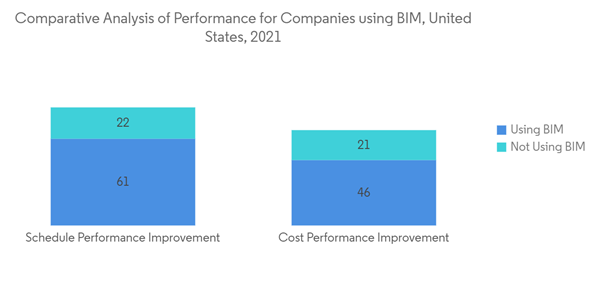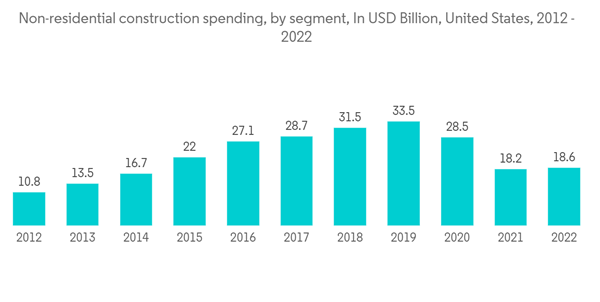The building sector in the United States is heavily reliant on supplies of steel, copper, aluminum, stone, and fixtures from other countries, many of which come from China.
Manufactured housing is a large segment with high demand in the US prefabrication construction market. The prefabrication market in the country is also witnessing demand for prefabricated housing types, including panelized and pre-cut. The drive to make housing more affordable, especially in high-demand areas like the San Francisco Bay area, encourages developers to move toward prefabrication solutions.
The prefabrication of multifamily buildings is still in its infancy in the United States. Most of the prefabricated multifamily buildings consist of wood-framed units that evolved from the products made by the manufacturers of single-family, mobile, and modular homes. Until recently, few steel modular experiments were undertaken. A Seattle company, Blokable, built its first steel units at its factory in Vancouver, Washington, for a 24-unit project in Edmunds, Washington.
The preference toward manufactured home solutions in the United States has been witnessing continuous growth, as this serves as the cost-effective alternative to conventional construction methods. This increasing preference is increasing the demand for manufactured homes, resulting in an increase in price in the country and modular housing.
US Prefabricated Buildings Market Trends
The Trend of BIM in the Prefab Sector
Precision planning and effective material management are crucial for prefabrication and modular construction. BIM speeds these procedures by providing precise quantity takeoffs, material schedules, and procurement data. Project teams can use BIM models to optimize material utilization, cut waste, and enhance inventory management. BIM also improves supply chain management by facilitating real-time cooperation and communication between suppliers, manufacturers, and contractors.According to an industry report on the advantages of BIM in prefab and modular construction, in the prefab industry, around 22% of the companies not using BIM claim that they experience schedule performance improvement, whereas the companies that use BIM in more than half of their projects, a significant 61% claim improvement in the performance. Along similar lines, with modular construction, only 21% of non-BIM users cite cost-performance improvement, whereas 46% of the BIM users report cost-performance improvement. The three main benefits of using BIM are an increase in project quality, a decrease in construction costs, and progress in the project schedule performance. BIM use is increasingly common in commercial and institutional projects in the United States.
The construction business is always changing and looking for new ways to increase productivity, cut costs, and finish projects on schedule. Building information modeling (BIM) integration in prefabrication and modular construction is one such development. Enhancing coordination, streamlining workflows, and maximizing the advantages of off-site construction techniques are all possible with BIM.
Growth in Residential & Non-Residential Sector to Boost the Prefab Share in the Market
Modular construction technology has been gaining more attention in the US building industry over the last few years. With rising housing costs, cities are beginning to invest in modular and prefab construction to deliver multifamily residential developments. This number has seen a rise in the past few years continuously owing to the demand for housing.Based on planned construction development over the next few years, non-residential construction in place is expected to reach 590.4 billion US dollars in 2023 in the United States. which includes segments like lodging, office, commercial, health care, and education. Non-residential construction will continue to improve if government spending continues to improve, allowing communities to contribute more resources to infrastructure.
The commercial building has experienced a comfortable growth in the non-residential building industry over recent years. However, the construction industry faces challenges such as a shortage of skilled labor and rising material costs due to global trade wars. The modernization of a generally conservative industry will be important in the near future to support customer demands as well as to improve operation models.
Integrating sustainable building processes and features in projects, as well as establishing technological advancements like building information modeling (BIM), will be essential for the future of the construction industry. The value of the new residential construction that is put in place in the US is projected to be around USD 600 billion by the year 2025.
With the increase in concern over carbon emissions, the green building concept is on the rise, and prefab modular construction is expected to see a lot of growth during the forecast period.
US Prefabricated Buildings Industry Overview
The report covers the major players operating in the USA's prefabricated buildings industry. The market is highly competitive, with no major players. The market is fragmented, and it is expected to grow during the forecast period due to the increase in prefab construction building investments and upcoming major projects in the country. Major players in the market include Skyline Champion Corporation, Plant Prefab, Z Module, etc.Prefabricated building systems and construction hold high potential to improve the efficiency and performance of the USA construction industry in a more sustainable sense. Venture Capital funding and experts from aerospace, semiconductor, and automotive manufacturing industries are entering the construction sector. With the market just opening up among the building industry generating trust, with investments in the technology -R&D, the market is open to ample opportunities and can witness strong growth in the coming years.
Additional Benefits:
- The market estimate (ME) sheet in Excel format
- 3 months of analyst support
This product will be delivered within 2 business days.
Table of Contents
Companies Mentioned (Partial List)
A selection of companies mentioned in this report includes, but is not limited to:
- Southern Structures, Inc.
- Walters Buildings
- Rubb Building Systems
- Safety Storage, Inc.
- Commercial Structures Corp.
- Panel Built, Inc.
- PortaFab Corp.
- Shea Concrete Products, Inc.
- Deluxe Building Solutions
- Modular Connections, LLC*
Methodology

LOADING...










